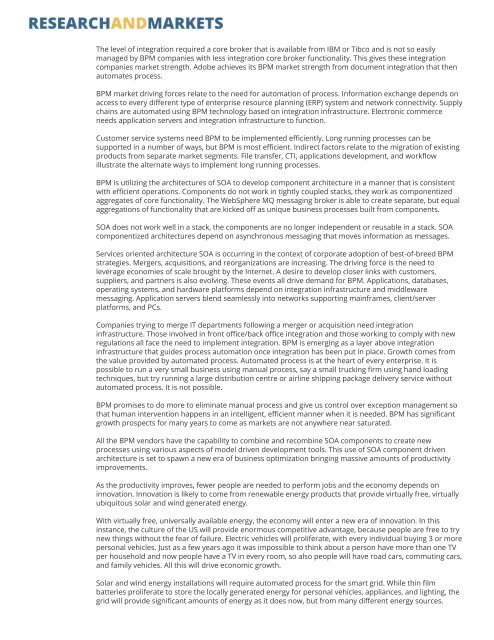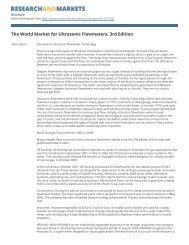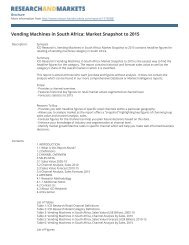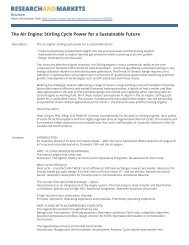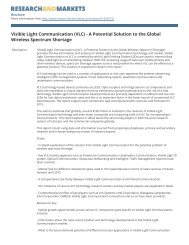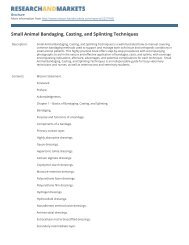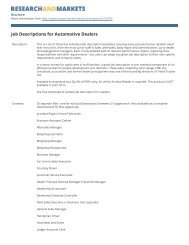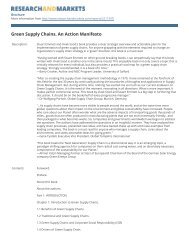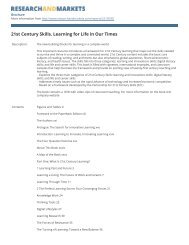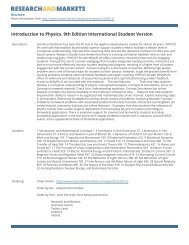Worldwide Business Process Management (BPM) - Research and ...
Worldwide Business Process Management (BPM) - Research and ...
Worldwide Business Process Management (BPM) - Research and ...
Create successful ePaper yourself
Turn your PDF publications into a flip-book with our unique Google optimized e-Paper software.
The level of integration required a core broker that is available from IBM or Tibco <strong>and</strong> is not so easily<br />
managed by <strong>BPM</strong> companies with less integration core broker functionality. This gives these integration<br />
companies market strength. Adobe achieves its <strong>BPM</strong> market strength from document integration that then<br />
automates process.<br />
<strong>BPM</strong> market driving forces relate to the need for automation of process. Information exchange depends on<br />
access to every different type of enterprise resource planning (ERP) system <strong>and</strong> network connectivity. Supply<br />
chains are automated using <strong>BPM</strong> technology based on integration infrastructure. Electronic commerce<br />
needs application servers <strong>and</strong> integration infrastructure to function.<br />
Customer service systems need <strong>BPM</strong> to be implemented efficiently. Long running processes can be<br />
supported in a number of ways, but <strong>BPM</strong> is most efficient. Indirect factors relate to the migration of existing<br />
products from separate market segments. File transfer, CTI, applications development, <strong>and</strong> workflow<br />
illustrate the alternate ways to implement long running processes.<br />
<strong>BPM</strong> is utilizing the architectures of SOA to develop component architecture in a manner that is consistent<br />
with efficient operations. Components do not work in tightly coupled stacks, they work as componentized<br />
aggregates of core functionality. The WebSphere MQ messaging broker is able to create separate, but equal<br />
aggregations of functionality that are kicked off as unique business processes built from components.<br />
SOA does not work well in a stack, the components are no longer independent or reusable in a stack. SOA<br />
componentized architectures depend on asynchronous messaging that moves information as messages.<br />
Services oriented architecture SOA is occurring in the context of corporate adoption of best-of-breed <strong>BPM</strong><br />
strategies. Mergers, acquisitions, <strong>and</strong> reorganizations are increasing. The driving force is the need to<br />
leverage economies of scale brought by the Internet. A desire to develop closer links with customers,<br />
suppliers, <strong>and</strong> partners is also evolving. These events all drive dem<strong>and</strong> for <strong>BPM</strong>. Applications, databases,<br />
operating systems, <strong>and</strong> hardware platforms depend on integration infrastructure <strong>and</strong> middleware<br />
messaging. Application servers blend seamlessly into networks supporting mainframes, client/server<br />
platforms, <strong>and</strong> PCs.<br />
Companies trying to merge IT departments following a merger or acquisition need integration<br />
infrastructure. Those involved in front office/back office integration <strong>and</strong> those working to comply with new<br />
regulations all face the need to implement integration. <strong>BPM</strong> is emerging as a layer above integration<br />
infrastructure that guides process automation once integration has been put in place. Growth comes from<br />
the value provided by automated process. Automated process is at the heart of every enterprise. It is<br />
possible to run a very small business using manual process, say a small trucking firm using h<strong>and</strong> loading<br />
techniques, but try running a large distribution centre or airline shipping package delivery service without<br />
automated process. It is not possible.<br />
<strong>BPM</strong> promises to do more to eliminate manual process <strong>and</strong> give us control over exception management so<br />
that human intervention happens in an intelligent, efficient manner when it is needed. <strong>BPM</strong> has significant<br />
growth prospects for many years to come as markets are not anywhere near saturated.<br />
All the <strong>BPM</strong> vendors have the capability to combine <strong>and</strong> recombine SOA components to create new<br />
processes using various aspects of model driven development tools. This use of SOA component driven<br />
architecture is set to spawn a new era of business optimization bringing massive amounts of productivity<br />
improvements.<br />
As the productivity improves, fewer people are needed to perform jobs <strong>and</strong> the economy depends on<br />
innovation. Innovation is likely to come from renewable energy products that provide virtually free, virtually<br />
ubiquitous solar <strong>and</strong> wind generated energy.<br />
With virtually free, universally available energy, the economy will enter a new era of innovation. In this<br />
instance, the culture of the US will provide enormous competitive advantage, because people are free to try<br />
new things without the fear of failure. Electric vehicles will proliferate, with every individual buying 3 or more<br />
personal vehicles. Just as a few years ago it was impossible to think about a person have more than one TV<br />
per household <strong>and</strong> now people have a TV in every room, so also people will have road cars, commuting cars,<br />
<strong>and</strong> family vehicles. All this will drive economic growth.<br />
Solar <strong>and</strong> wind energy installations will require automated process for the smart grid. While thin film<br />
batteries proliferate to store the locally generated energy for personal vehicles, appliances, <strong>and</strong> lighting, the<br />
grid will provide significant amounts of energy as it does now, but from many different energy sources.


